
III(2)_Unit_5_MassMedia_ST
.pdf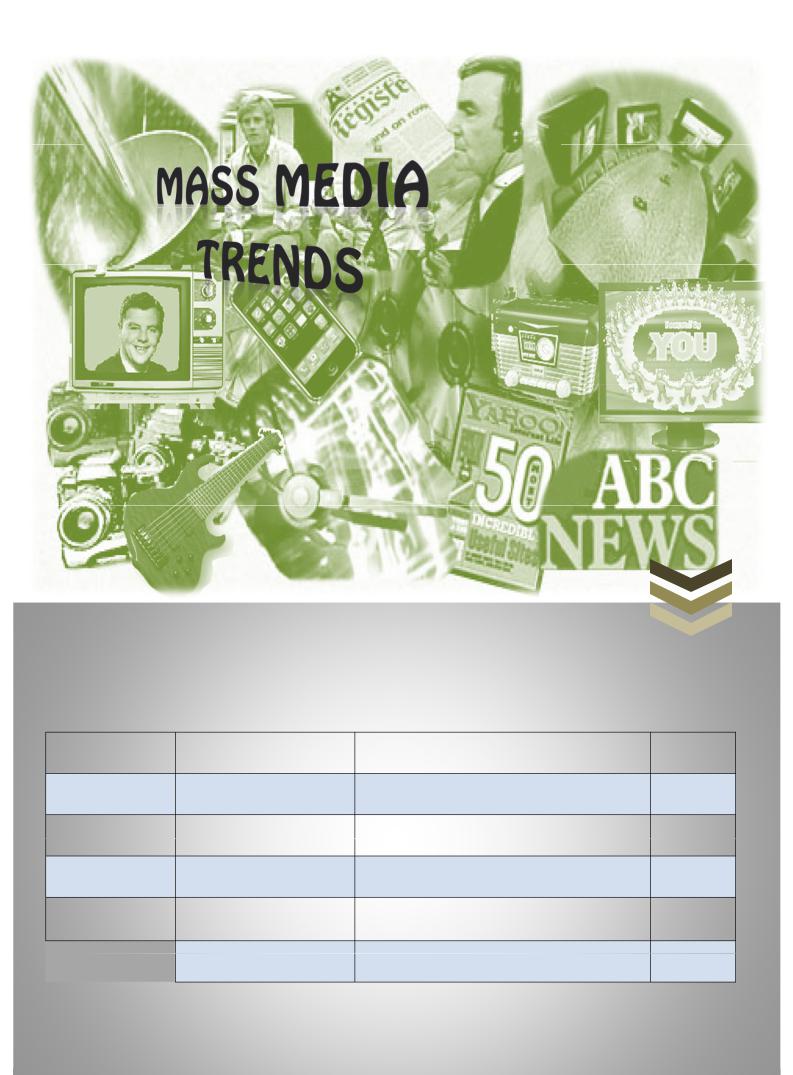
Unit 5
Lesson 1 |
Lead-in |
Media World |
p.1 |
Lesson 2 |
Advertising |
||
Lesson 3 |
Theme One |
Mass vs. Social Media |
p.8 |
|
Theme Two |
|
p.14 |
Lesson 4 |
Talking Points |
Role Play |
p.20 |
|
Vocabulary |
|
p.24 |
|
Vocabulary Practice |
|
p.29 |
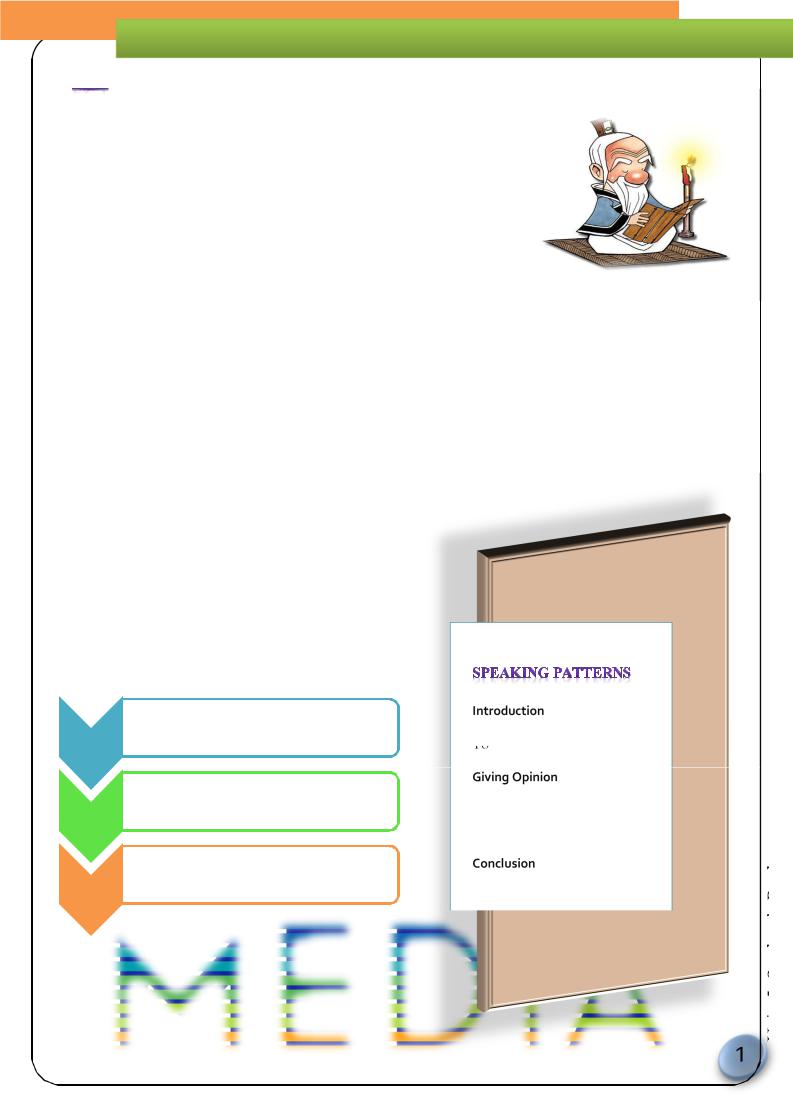
Lead-In: Media World

 Here some English sayings and proverbs about mass media. What do the sayings imply?
Here some English sayings and proverbs about mass media. What do the sayings imply?
1)Cinema, radio, television, magazines are a school of inattention; people look without seeing. Christine McQuade, US modern dancer.
2)TV captures the imagination, but does not liberate it. A good book at once stimulates and frees the mind. Bruno Bettelheim.
3)TheInternet is a tool that can be used for good or evil. It can misinform as easily as it enlightens and offend as quickly as it entertains. Its potential is as limitless as human curiosity. H. D. Greenway, U.S. journalist.
4)Were it left to me to decide whether we should have a government without newspapers or newspapers without government, I should not hesitate a moment to prefer the latter. Thomas Jefferson, third president of the United States.
5)Rapidly our technology is creating a new type of human being, one who is plugged into machines instead of relationships, one who lives in a virtual reality rather than a family. Mary Pipher, U.S. professor and author.
6)Without question, the most importantinvention in human history, next to frozen yogurt, is the computer. Dave Barry, U.S. humor columnist.
7)The Internet is, by far, the greatest and most significant achievement in the history of mankind. What? Am I saying thatthe Internet is more impressive than the pyramids? More beautiful than Michelangelo's David. Moreimportantto mankindthan the wondrous inventions of the industrial revolution? Yes, yes, and yes.
8)You can tell the ideals of a nation by its advertisements.
1 |
• Interpret the quote |
• Dis/agree withthe quote |
2 • Support your opinion with arguments
• Make a conclusuion
3
To begin with …
To my way of thinking, … From my experience, …
In conclusion …
Unit 5: Student’s Book


 Answer the following questions.
Answer the following questions.
1.How often do you read the paper or watch the news on TV?How important is it for you to keep up with current events?
2.In your opinion, what has been the single biggest news item from this past year? How did the media cover this event?
3.Do you think that news reporting has gotten better, gotten worse, or stayed thesame over your lifetime?
4.Do you think a politician's private life is newsworthy? Whyor why not?
5.Are there certain things journalists shouldn't reporton? Why?
6.How do you feel about censorship? Are there times when the news should be censored?
7.Who owns the newspapers and TV stations in your country? Do you think this has an effect on the news that you hear?
8.Do you think that the media covers too much bad news and not enough good news? What was the last "good news" story you heard?
9.How has technology affected the way that we receive news?
10.Have you (or anyone you know) ever been in the newspaper/on TV? If so, what for?
11.Do you think that most newspapers print what's really important, or what will make them sell more newspapers? What about TV news?
12.Do you think that the media is objective? Why or why not?
13.What's happening in the news right now, both in your country and abroad? Where did you hear about it?
Useful language
Media: newspapers, journals, magazines, TV, the Internet, radio, social networks The source: reliable, direct, objective, entertaining, uncompromising, serious, glossy,
easily available,
The author: dispassionate, determined, impartial, unbiased An article: well-researched, revealing, hard-hitting
Unit 5: Student’s Book
2


 Complete each sentence with one of the words or phrases given.
Complete each sentence with one of the words or phrases given.
1. |
circulation |
8. |
obituaries |
15. |
sensationalism |
2. |
coverage |
9. |
censorship |
16. |
broadsheet |
3. |
tabloid |
10. |
tuned in |
17. |
slogans |
4. |
censorship |
11. |
feature |
18. |
readership |
5. |
correspondent |
12. |
newscasters |
19. newscaster |
|
6. |
editorial |
13. |
logo |
|
|
7. |
supplement |
14. |
bias |
|
|
1.The ………………………..… newspapers are printed onsmall pages and usually contain light or popular news stories, while a newspaper that isprinted on large pages is called a………………………..….
2.On Sundays I often read the glossy color ………………………..… before I turn to the main newspaper.
3.Although we publish a university newspaper, our ………………………..… extends far beyond the students attendingthe college.
4.Although we sold more copies than we did in January,………………………..… circulation figures are still not satisfactory.
5.There will be a special………………………..… on health education in nextweek’s Sunday Times.
6.David works as a foreign ………………………..… for the Daily Telegraph.
7.When Picasso died, all major newspapers carried ………………………..… on him.
8.The editor’s opinion on important current events can be found in the………………………..….
9.There was extensive media………………………..… of the Kyoto climate treaty talks.
10.In certain countries, ………………………..… of the pressmeans that not allpolitical opinions can be printed.
11.TV programs on the ITV network are interrupted atregular intervals for………………………..….
12.“Drinka Pinta Milka Day”, “Go to Work on an Egg”: these are two examples of highly successful advertising ………………………..….
13.An estimated eight and half million viewers ………………………..… to BBC coverage of the Olympic Games.
14.Companies are now so design-conscious that they employ specialists to find them an eye-catching
………………………..….
15.………………………..… , whose faces are seen every night as they read thenews, frequently become celebrities.
16.While many newspaper editors tryto guard againstthe………………………..… of facts in their reports, it is inevitable that some………………………..… will creep into the way events are reported.
17.The ………………………..… of the popular press, for example in the reporting of sex scandals, is one explanation for its success.
Unit 5: Student’s Book
3
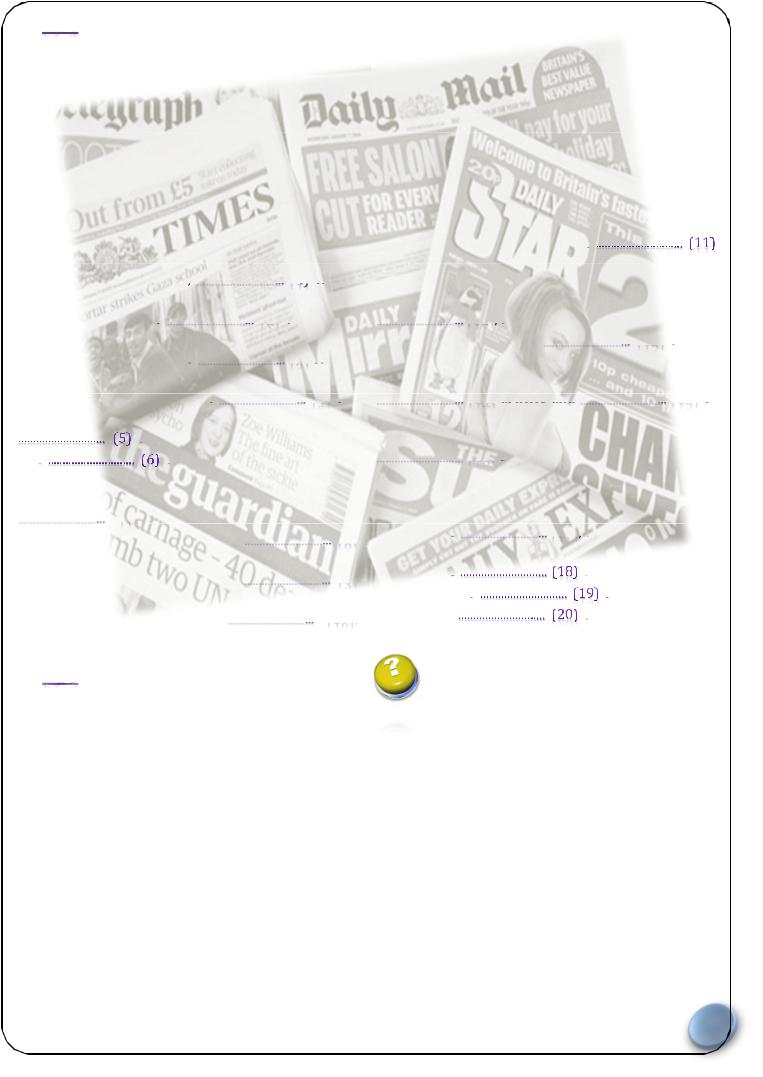

 Complete the text using the words and phrases given.
Complete the text using the words and phrases given.
1. |
target |
8. |
exposing |
15. tending |
2. |
profitability |
9. |
classified |
16. circulation figures |
3. |
boost |
10. |
coverage |
17. catering |
4. |
handled |
11. |
readership |
18. reviews |
5. |
feature |
12. |
massmarket |
19. market share |
6. |
proprietor |
13. |
salesgimmicks |
20. provide |
7. |
in-depth |
14. cover price |
||
The Pressin Britain
A wide variety of newspapers ispublished in Britain, and newspaper readers are generally loyal to the newspaper of their choice, 
 to buy the same newspaper every day. The papers themselves vary from
to buy the same newspaper every day. The papers themselves vary from 
 dailies and Sunday papers distributed nationwide to regional, evening and weekly papers
dailies and Sunday papers distributed nationwide to regional, evening and weekly papers 
 for the needs of people in a particular geographical area.
for the needs of people in a particular geographical area.
The papers with the highest 
 are the national tabloids which try to maintain their
are the national tabloids which try to maintain their 
 by publishing sensational stories and
by publishing sensational stories and 
 the private lives of people in the public eye. Readership of the tabloids is concentrated among less affluent social groups, and
the private lives of people in the public eye. Readership of the tabloids is concentrated among less affluent social groups, and 
 is an important aspect of newspaper choice in this sector.
is an important aspect of newspaper choice in this sector. 

 such as competitions with spectacular prizes are a common means of attempting to
such as competitions with spectacular prizes are a common means of attempting to 
 sales.
sales.
For more extensive news 
 readers may turn to the broadsheets, where in the
readers may turn to the broadsheets, where in the

 Answer the following questions.
Answer the following questions.
best cases there is an attempt at 

analysis of the current situation both at home and abroad. As in the case of tabloids, the editor has an important role to play in determining how a story is 
 , but more and more frequently the views of the newspaper
, but more and more frequently the views of the newspaper 
 have a role to play.
have a role to play.
Both tabloids and broadsheets provide 
 articles and
articles and 




 of current books, films, plays and so forth. Sport also receives substantial coverage. Many newspapers now
of current books, films, plays and so forth. Sport also receives substantial coverage. Many newspapers now  advice on how to handle personal
advice on how to handle personal
finances, as well as a more traditional business section.
Advertising revenue is an essential element in a newspaper's 
 , and advertisers take
, and advertisers take
account of the social characteristics of a particular newspaper's 
 when determining at
when determining at
which group to 
 a particular sales promotion.
a particular sales promotion. 

 advertising is also a valuable source of income.
advertising is also a valuable source of income.
1. |
Is there a newspaper in your country that you are loyal to? Do you tend to read newspapers every |
|
2. |
day? |
|
Describe how the newspapers vary in GB. Whose tastes and needs do different newspapers cater |
|
|
3. |
for? What is the difference between tabloids and broadsheets? |
|
What are the papers with the highest circulation figure in G.B.and in Russia? Howdo newspapers |
|
|
4. |
maintain their profitability? |
Book |
Do you think newspapers have the right to expose the private lives of people in the public eye? Why |
||
5. |
are people so interested in the private lives of celebrities? |
|
What gimmicks are frequently used in order to boost newspaper sales in G.B. and in your country? |
5:UnitStudent’s |
|
6. |
family/friends, or someone else? Why? |
|
What kind of newspapers dopeople in Britainturn to for more extensive news coverage? What |
|
|
|
newspapers in your country make an attempt at in-depth analysis of the current situation at home |
|
7. |
and abroad? |
|
Who plays an important role in determining how a story is handled? |
|
|
8. |
Who do you trust more to help you understand world events: the press, politicians, your |
|
4
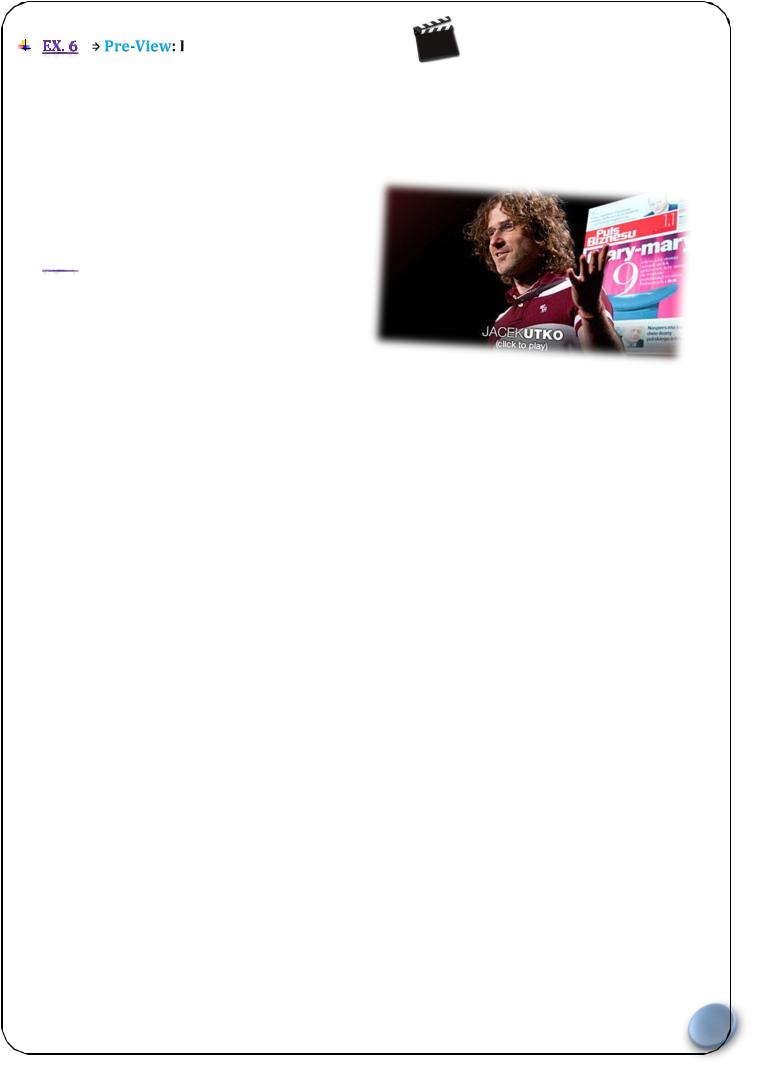
|
Discuss the following points. |
Some journalists claim that today the paper editions of newspapers are dying. Readers and advertisers
are migrating tothe papers’ Web sites, thus reducing revenue of the print editions.
Do you think newspapers will really die out? If so, when? What are your predictions?
Is it possible to save newspapers?
Is it necessary to do so?

 Watch the video episode where Jacek Utko, a Polish newspaper designer, explains how good design can save the newspaper. Fill in the chart below.
Watch the video episode where Jacek Utko, a Polish newspaper designer, explains how good design can save the newspaper. Fill in the chart below.
Reasons why |
Possible scenarios |
Lessons Jacek’s |
Threeelements |
newspapersare |
for the future |
design teaches |
you need to be |
dying |
newspaper |
|
successful |
|
|
|
|
|
|
|
|
|
|
|
|
|
|
|
|
Unit 5: Student’s Book
5
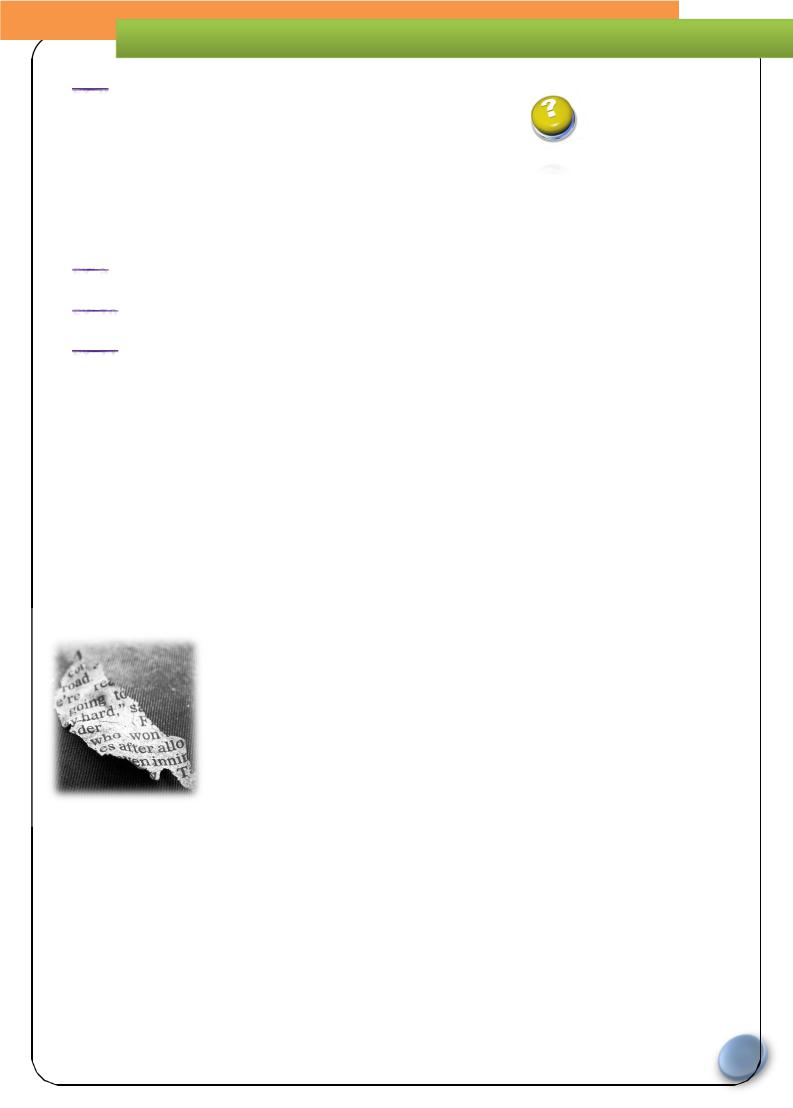
Hometask 1

 Watch theepisode from ex. 7 again.Be ready to answer the following questions.
Watch theepisode from ex. 7 again.Be ready to answer the following questions.
1)What did Jacek change in his approach to the newspaper?
2)What happened to the circulationof newspapers after their redesign?
3)How does Jacek Utko view redesign?
4)Why does he say that his approach to workwas very egotistic.
5)What does he feel responsible for?
6)Comment on Jacek Utko’s statement: “The frontpage became our signature”.

 Study thevocabulary from exercises 2, 3, 4.
Study thevocabulary from exercises 2, 3, 4.

 Get ready to retell the text from Ex. 4.
Get ready to retell the text from Ex. 4.


 Read the text below. Ryan Thomasgives10 reasons why the newspaperis dying
Read the text below. Ryan Thomasgives10 reasons why the newspaperis dying
today. Prioritize these reasons. Be ready to discuss.
Top 10 Reasons the Newspaper is Dying.
Looking back upon the heyday of the newspaper industry, images of angry cigar-smoking editors, journalists with fedoras carrying “press” cards and sharpened pencils, and little Dickensian children on the street corner shouting “Read all about it!” are evoked. That was back when nothing MORE than newspapers existed, that is in the form of competition. Yes, the paper was as cutting edgeas the refrigerator back when the nation relied on its local street urchin to find out what was new in the world. Nowadays, in spite of a good many paperboys who regularly find summer employment, it’s the tech-savvy youth that are primarily responsible for the undoing of anachronistic traditions.
You’d think an industry whose very purpose is to keep regular tabs on the status quo would be able to adapt to an ever-changing environment, but such was apparently not the case as an industry of old dogs failed to learn any new tricks (instead
they just continued licking themselves). Here’s a look at the top ten reasons why not all traditions are timeless, and particularly why the newspaper industry is folding under itself (andbeing held inplacewith a rubberband).
Reason10: It’s MadeByand Aimed at “Old People.” You’re going to lose a lot of business targeting the most
transient demographics, the ones on the way out the door, whereas there is a lot of money in tapping into the prodigal youth. You want to secure a placein the hearts of those that really pull all the strings, the ones that willinherit the earth one day. To simply secure the ports of every hospital feeding tube is extremely short-sighted. Most successful business models aren’t based on a client-base that
by Ryan Thomas remembers when things used to cost a nickel (e.g. Facebook, iPods, any beverage ever, etc.). Not only do newspapers adapt poorly to an internet model, they also seem to be completely clueless about what appeals to younger demographics (beyond the extremely topical). That’s a matter of external research, but try telling any stubborn print publication run by complacent old coots to look outsideof itself.
Reason9: No passion.
When you read any front page news story, chances are it’ll be the driest, most cliche-prone pile of bullet points you’ll find outside of a reporter’s notebook. Beyond the basic story elements (the ol’ “Who, What, When, Where, Why and How”) there is rarely any narrative or creative expansion, really no more than the laziest consolidation of a tape recorder’s content. The straight-forwardness is crucial to the relay of the most vital information, but more than being just a journalist (but a bona fide writer), the material should be at least interpreted in a way that would appeal to those otherwise uninterested in bland subject matter (e.g. real estate, finances, etc.). Or just keep on writing toappeasetheroutine-seekers…
Reason8: There’s no journalism inthejournalism. How much of the news we receive really matters?
Relevance is the crux of the news industry for sure, but is a car accident or local robbery really relevant to anyone who doesn’t confuse breaking news with gossip? There are two types of news: “hard news” and “soft news.” The former would be like a local politician passing a bill or a murder, while the latter would be something like a business profile or feature on a kid in a wheelchair who can do Pee-Wee Herman impressions. The difference is in how immediate or timely a story is. But what should matter most is how much a story resonates with us as humans, not so
much as how a story appeals to our lowest
6
Unit 5: Student’s Book
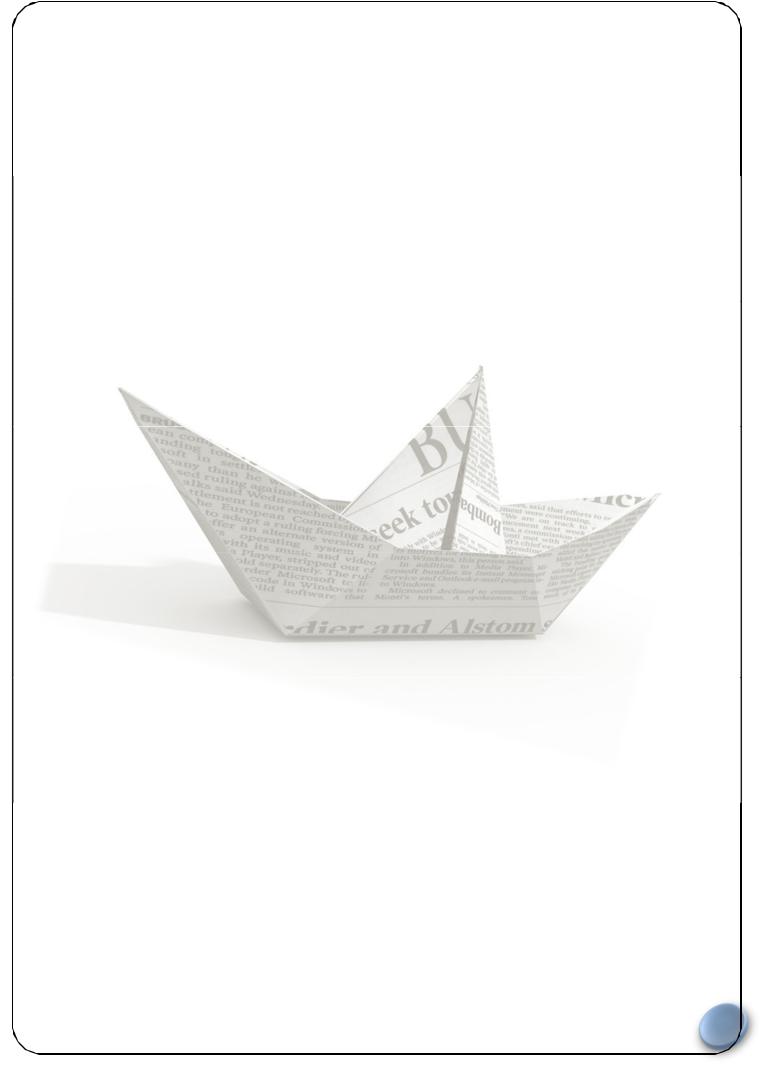
instincts to draw us in. When politics enter the newsroom, papers often use common affiliations to solicit to large, generic groups of people. Journalism should be a neutral platform to which everyone can subscribe unequivocally, not just those onthe insideof theslant.
Reason7: Reason: It’s Impracticaland Inconvenient. This is the reason a lot of retro-technology is pushed
aside so quickly for the next flashy thing. Vinyl records became immediately more bulky and involved as soon as CD’s came about, as convenience is always preferred to quality or substance. Accordingly, it’s completely impractical to dig through a compost pile of newspapers to ascertain a news story from last year; whereas with the internet, archives exist, and virtually nothing is out of reach with a single laptop or handheld smartphone with internet access. Then there’s the matter of paper waste, the very reasonhardcoregreen-heads don’t read thepaper.
Reason6: Reason: It Costs Money.
As the old adage goes, why pay for something that’s free? This is the very ideology that devastates the music industry and paper industry alike. Like pirated music, news is very much available for free on the internet, largely from websites pertaining to major city newspapers. With that being the case, news being readily accessible, and streamed to your homepage even, it seems redundant to pay a monthly subscription to hear the same thing from a pile of carbon (or digital equivalent). And that is the central problem with thenewspaper, it really offers nothing new.
Reason5: It Requires Literacy.
Simply put, most Americans don’t like to read, recreationally or otherwise. Newspapers endorse literacy implicitly on a daily basis. Granted, the industry is aimed at the least educated-types for a reason, as people don’t often have the attention span to sit down and absorb a single thing without being simultaneously stimulated by 18 others. Truth be told, if the paper didn’t have so many fullpage pictures, or a funnies section, it would’ve died a long time ago (some people get all their news from Doonesbury alone).
Reason4: WastefulOverhead.
Between large headquarters, lofty offices, salaried employees and warehouses containing cumbersome printing presses which use (i.e. waste) all sorts of ink and paper every day, a lot of money goes into the daily newspaper that shows up at your door step every morning. All that money is exactly what keeps the industry from garnering any viable or growth-enabling profit margins, when online-based newspapers (like AOL’s Patch) are accountable for virtually no overhead (operating mostly out of coffee shops and a host website, in lieu of a physical headquarters) and make all their money through ad revenue. This is the Age of DIY, digital music, E-books and reality TV: less materialequals moreroom forprofits.
Reason3: BigBusiness Pretensions.
Again, the newspaper industry still thinks it’s on the same page as Wall Street, Big Oil and Big Tobacco, and can maintain that Tony Montana business ethos of wasteful expenditures and general impetuosity. It’s almost foolish to think you can keep up a business full of highly-demanding, not to mention overpaid, staff members, providing benefits and the kinds of perks that are usually found in the fluffiest regions of the corporate world. But when starving journalists fresh out of grad school are willing to do the exact same work for a lot less, and with a lot more zeal for the trade as an art form, it becomes a million times more practical to take on a body of freelancers who cut overhead into a fractional value. But if you insist on guaranteeing each employee gets a new jet ski or swimming pool full of caviarfora Christmas bonus, so beit.
Reason2: CableNews.
With cable news, reading is obsolete. This is exciting for people uninterested in maintaining the acuteness of their wits. For those who like doing no work and reaping all the benefits, including a dash of enlightenment, it’s a sheer delight to be able to watch television and effortlessly absorb all the necessary points a newspaper requires you to sift for. This is huge competition for such a literacydependent medium as the newspaper. Not only that, the paper only comes once a day, meaning that anything that happens thereafter can’t be reported until the very next day. Cable news on the other hand can report a story on the minute and as it happens, even before it happens; for instance, when the news of Osama BinLaden’s death hadn’t yet been made official, CNN was there to break it as it was being relayed from various sources and inside informants, who were alluding to some “important announcement” to be made by the President. The paper “broke” this news the following morning.
Reason1: TheInternet.
Theinternet is responsiblefora lot of deaths. Primary, thedeath of humanity. Throughit, peopleno longer need interact faceto faceorleavetheirhouses to buy things or evenwork (insomecases). Whennews canbebrokenthe second it happens, orat least as long as it takes fora witness to typeit and publish it online(with Twitteror Facebook, that is only seconds), it’s a remarkablething. That is unless yourbusiness modelstilloperates ona once/day basis. Inthatcase, you comeoffas perpetually slow to thepunch, nothing morethana recapof what’s already beensaid/revealed. It is forthat reasonthat the newspaperis no longera practicalway to receive information, that iswhenit comes to thevery topical. Since most papers don’t dig much furtherthanthetopical, it is not introducing a new element and hardly a fresh perspective. Thereis a lot to say fora tangibleproduct, but theproduct injournalism really comes downto a single abstraction: knowledge. That iswhat needs to besold effectively. Sadly, there’s nothing effectiveabout a newspaperanymore.
7
Unit 5: Student’s Book

Theme One: Advertising


 Comment on the following quotations?
Comment on the following quotations?
1)Let advertisers spend the same amount of money improving theirproduct that they do on advertising and they wouldn'thave to advertise it.
2)Advertising - a judicious mixture of flattery andthreats.
3)Advertising degrades the people it appeals to; it deprives them of their will to choose.
4)You can tell the ideals of a nation by its advertisements.
5)What is the difference between unethical and ethical advertising? Unethical advertising uses falsehoods to deceive the public; ethical advertising uses truth to deceive the public.
6)Advertisers constantly invent cures to which there is no disease. In general, my children refused to eat anything that hadn't danced on TV.
Useful language
Types: ad, advert (BrE), advertisement (for sth), leaflet, advertorial, commercial, billboard, productplacement, endorsement, free samples, on-line advertising, junk mail, classified ad, trailer, pop-up ad, sponsorship
aggressive, effective, colorful, funny, annoying,helpful,obtrusive


 What types of ads can you see on the pictures below(use suggestions from the
What types of ads can you see on the pictures below(use suggestions from the
“Useful Language” box above).
It can be difficult to decide the best way to advertiseyour product or service. Different media(singular:
medium =way of communicating your message)have their own advantages and disadvantages.
Unit 5: Student’s Book
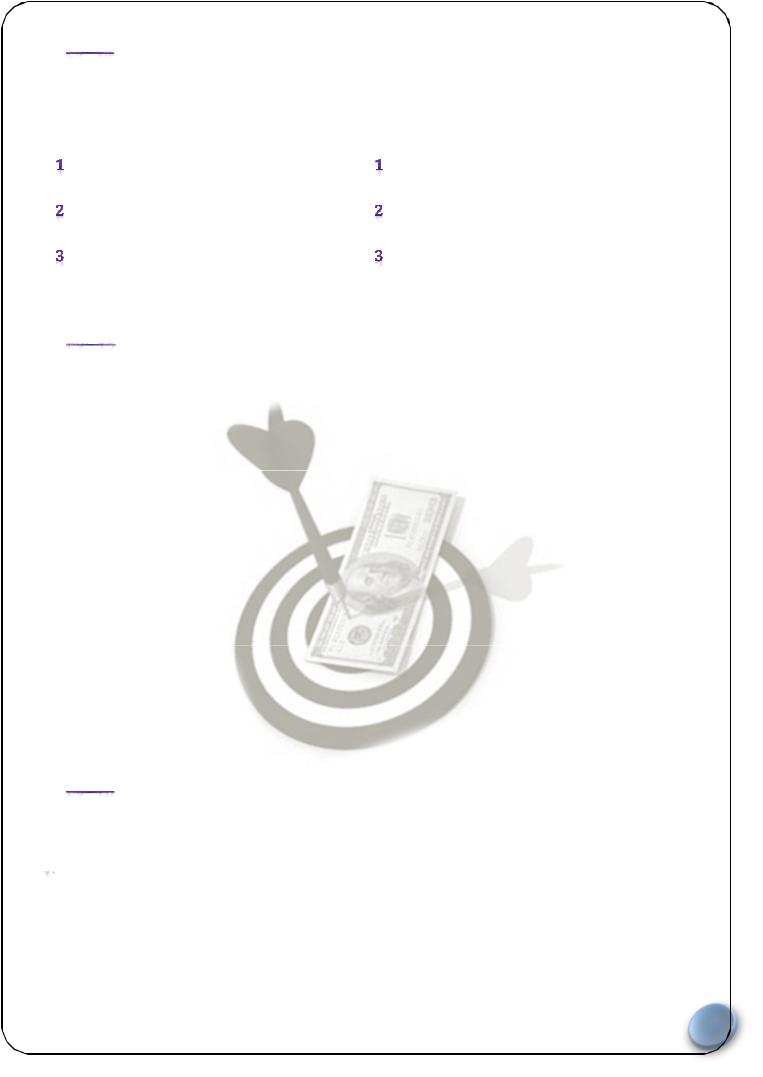


 Choose one of the advertising methods in the photos and make a list of its
Choose one of the advertising methods in the photos and make a list of its
advantages and disadvantages. Try to think of three advantages and three disadvantages.
Advantages |
Disadvantages |
|
|
|
|
|
|


 Read these paragraphs from a book about advertising and decide which advertising medium (a-f) each paragraph (1-4) describes. There are more media than you need.
Read these paragraphs from a book about advertising and decide which advertising medium (a-f) each paragraph (1-4) describes. There are more media than you need.
1.This form of advertising can reach a large number of homes. Consumers can take their time over the message so it can contain details like phone numbers or website addresses. However, adverts here have a short lifespan as most people throw them away after one day.
2.With this marketing technique, you can direct your message to the people who are most likely to buy your product or service. You can focus on a particular area of a city or on previous customers. However, it can be difficult to get your audience’s attention as some people throw these away without even looking at them.
3.This medium allows you to reach a large number of people in a short space of time. Perhaps its main advantage is that you can get your message across with both visual images and sound. The problem for many businesses is that it is expensive. You need to have plenty of money to pay for the cost of producingthe ad and to pay for a suitable time to show it.
4.This type of advertising certainly reaches its audience because people can’t switch it off or throw it away. However, consumers are usually moving at the time, so they only see the ad for about two or three seconds. It is normally used to remind consumers of messages which other media have already communicated to them.

 Of course, some techniques that advertisers use are not always completely
Of course, some techniques that advertisers use are not always completely
honest and may even be illegal. Read the following two situations and discuss them with your partner. Do you think theyare acceptable practice or not?
 A pizza restaurant advertised pizzas at half price for a week. However, when customers were
A pizza restaurant advertised pizzas at half price for a week. However, when customers were
inside the restaurant, they were told that to get the half price pizza, they had to buy a dessert as well.
 The marketing team for a brand of household detergent decided to target the “Green”
The marketing team for a brand of household detergent decided to target the “Green”  consumer. They put the detergent in a newly designed bottle with a pattern of green leaves and added the words “no polluting phosphates”. However, their detergent never contained phosphates in the past and neither did any of their competitors’ brands.
consumer. They put the detergent in a newly designed bottle with a pattern of green leaves and added the words “no polluting phosphates”. However, their detergent never contained phosphates in the past and neither did any of their competitors’ brands.
9
Unit 5: Student’s Book
